

Compact Muon Solenoid
LHC, CERN
| CMS-PAS-TOP-17-020 | ||
| Search for new physics via top quark production in dilepton final state at 13 TeV | ||
| CMS Collaboration | ||
| September 2018 | ||
| Abstract: A search for new physics in top quark production is performed in proton-proton collisions at 13 TeV. The data-set corresponds to an integrated luminosity of 35.9 fb−1, and was collected in 2016 by the CMS detector. Events with two isolated leptons (electrons or muons) and b quark jets in the final state are selected. The search is sensitive to new physics in top quark pair production and in single top quark production in association with a W boson. This is the first search for new physics that uses the tW process. No significant deviation from the standard model expectation is observed. Results are interpreted in the framework of an effective field theory and constraints on the relevant effective couplings are set using a dedicated multivariate analysis. | ||
|
Links:
CDS record (PDF) ;
CADI line (restricted) ;
These preliminary results are superseded in this paper, EPJC 79 (2019) 886. The superseded preliminary plots can be found here. |
||
| Figures | |

png pdf |
Figure 1:
Representative Feynman diagrams for the tW (left panel) and t¯t (right panel) production at leading order. The upper row gives the SM diagrams, the middle and lower rows present diagrams corresponding to the O(3)ϕq, OtW,OtG, OG and Ou/cG contributions. |
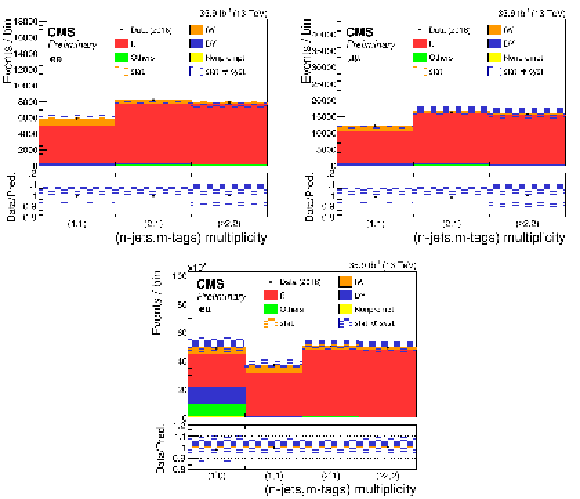
png pdf |
Figure 2:
The observed numbers of events and SM background predictions in the search regions of the analysis for the ee (upper left), μμ (upper right) and eμ (lower) channel. The hatched band corresponds to the quadratic sum of statistical and systematic uncertainties in the event yield for the SM background predictions. The ratios of data to the sum of the predicted yields are shown at the bottom of each plot. The narrow hatched band represents the contribution from the statistical uncertainty in the MC simulation. |

png |
Figure 2-a:
The observed numbers of events and SM background predictions in the search regions of the analysis for the ee (upper left), μμ (upper right) and eμ (lower) channel. The hatched band corresponds to the quadratic sum of statistical and systematic uncertainties in the event yield for the SM background predictions. The ratios of data to the sum of the predicted yields are shown at the bottom of each plot. The narrow hatched band represents the contribution from the statistical uncertainty in the MC simulation. |
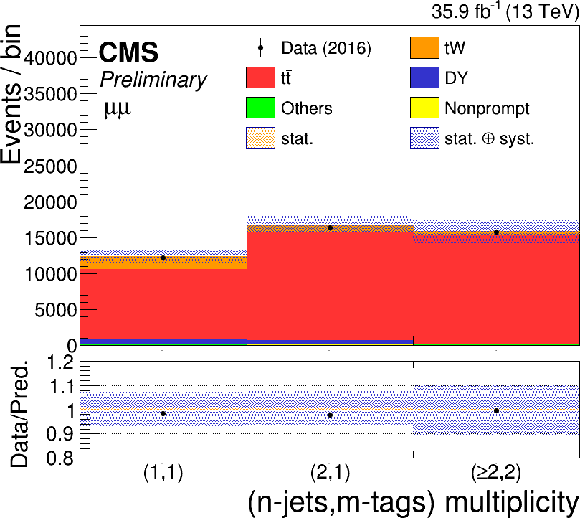
png |
Figure 2-b:
The observed numbers of events and SM background predictions in the search regions of the analysis for the ee (upper left), μμ (upper right) and eμ (lower) channel. The hatched band corresponds to the quadratic sum of statistical and systematic uncertainties in the event yield for the SM background predictions. The ratios of data to the sum of the predicted yields are shown at the bottom of each plot. The narrow hatched band represents the contribution from the statistical uncertainty in the MC simulation. |

png |
Figure 2-c:
The observed numbers of events and SM background predictions in the search regions of the analysis for the ee (upper left), μμ (upper right) and eμ (lower) channel. The hatched band corresponds to the quadratic sum of statistical and systematic uncertainties in the event yield for the SM background predictions. The ratios of data to the sum of the predicted yields are shown at the bottom of each plot. The narrow hatched band represents the contribution from the statistical uncertainty in the MC simulation. |
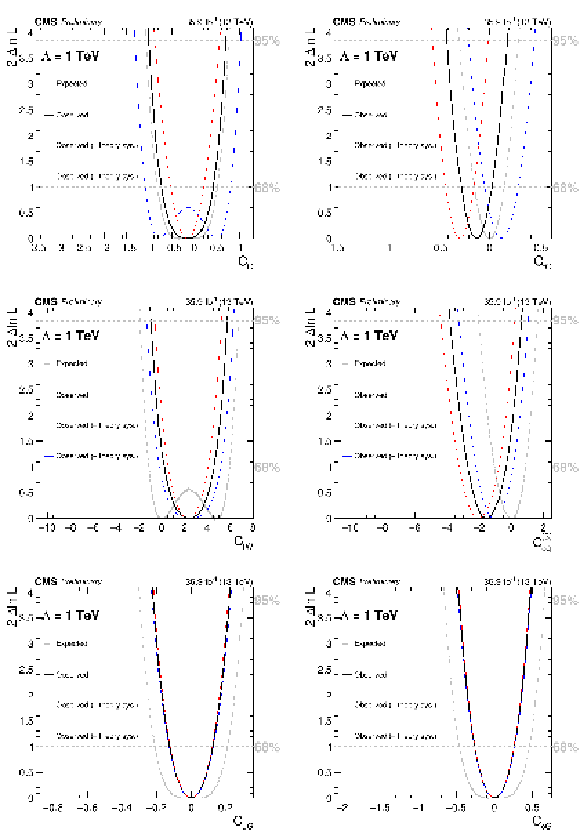
png pdf |
Figure 3:
Observed (solid) and expected (dashed) likelihood scans of the effective couplings: CG (upper left) and CtG (upper right), CtW (middle left), Cϕq (middle right), and CuG (lower left) and CcG (lower right). The thick curves indicate the nominal fit and the other curves represent fits to the observed data with the variations of normalization due to the theoretical uncertainties. |
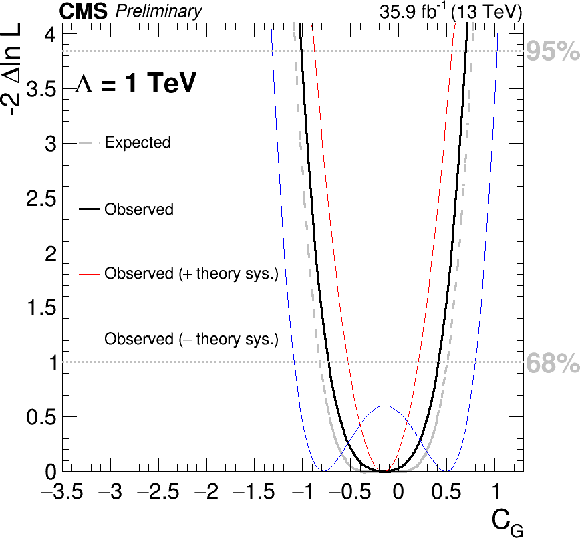
png |
Figure 3-a:
Observed (solid) and expected (dashed) likelihood scans of the effective couplings: CG (upper left) and CtG (upper right), CtW (middle left), Cϕq (middle right), and CuG (lower left) and CcG (lower right). The thick curves indicate the nominal fit and the other curves represent fits to the observed data with the variations of normalization due to the theoretical uncertainties. |

png |
Figure 3-b:
Observed (solid) and expected (dashed) likelihood scans of the effective couplings: CG (upper left) and CtG (upper right), CtW (middle left), Cϕq (middle right), and CuG (lower left) and CcG (lower right). The thick curves indicate the nominal fit and the other curves represent fits to the observed data with the variations of normalization due to the theoretical uncertainties. |
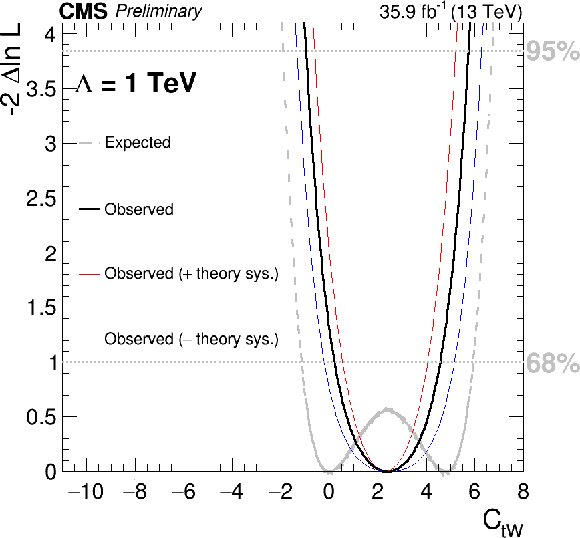
png |
Figure 3-c:
Observed (solid) and expected (dashed) likelihood scans of the effective couplings: CG (upper left) and CtG (upper right), CtW (middle left), Cϕq (middle right), and CuG (lower left) and CcG (lower right). The thick curves indicate the nominal fit and the other curves represent fits to the observed data with the variations of normalization due to the theoretical uncertainties. |

png |
Figure 3-d:
Observed (solid) and expected (dashed) likelihood scans of the effective couplings: CG (upper left) and CtG (upper right), CtW (middle left), Cϕq (middle right), and CuG (lower left) and CcG (lower right). The thick curves indicate the nominal fit and the other curves represent fits to the observed data with the variations of normalization due to the theoretical uncertainties. |

png |
Figure 3-e:
Observed (solid) and expected (dashed) likelihood scans of the effective couplings: CG (upper left) and CtG (upper right), CtW (middle left), Cϕq (middle right), and CuG (lower left) and CcG (lower right). The thick curves indicate the nominal fit and the other curves represent fits to the observed data with the variations of normalization due to the theoretical uncertainties. |

png |
Figure 3-f:
Observed (solid) and expected (dashed) likelihood scans of the effective couplings: CG (upper left) and CtG (upper right), CtW (middle left), Cϕq (middle right), and CuG (lower left) and CcG (lower right). The thick curves indicate the nominal fit and the other curves represent fits to the observed data with the variations of normalization due to the theoretical uncertainties. |
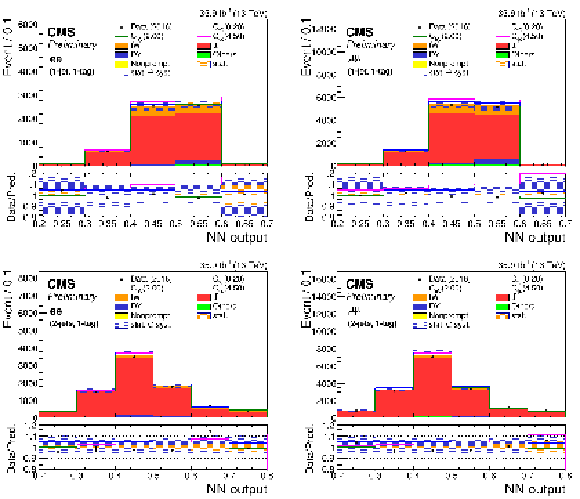
png pdf |
Figure 4:
The NN output distributions for data and MC in different categories: (1-jet,1-tag) (upper row), (2-jets,1-tag) (lower row) used in the limit setting for the ee (left column) and μμ (right column) channels. The hatched band corresponds to the sum of the statistical and systematic uncertainties in the event yield for the sum of signal and background predictions. The ratios of data to the sum of the predicted yields are shown at the bottom of each plot. The narrow hatched band represents the contribution from the statistical uncertainty in the MC simulation. |

png |
Figure 4-a:
The NN output distributions for data and MC in different categories: (1-jet,1-tag) (upper row), (2-jets,1-tag) (lower row) used in the limit setting for the ee (left column) and μμ (right column) channels. The hatched band corresponds to the sum of the statistical and systematic uncertainties in the event yield for the sum of signal and background predictions. The ratios of data to the sum of the predicted yields are shown at the bottom of each plot. The narrow hatched band represents the contribution from the statistical uncertainty in the MC simulation. |
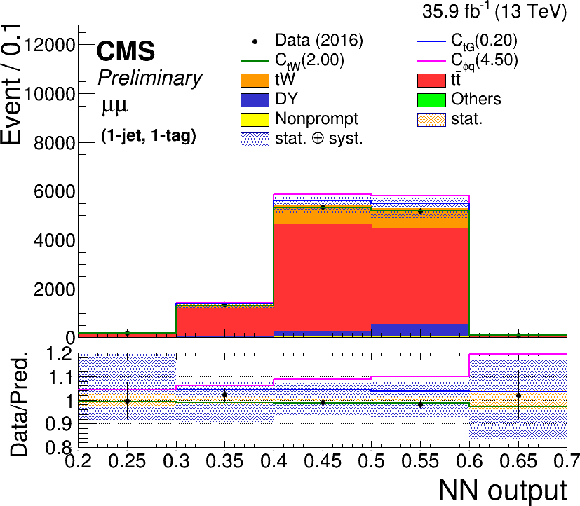
png |
Figure 4-b:
The NN output distributions for data and MC in different categories: (1-jet,1-tag) (upper row), (2-jets,1-tag) (lower row) used in the limit setting for the ee (left column) and μμ (right column) channels. The hatched band corresponds to the sum of the statistical and systematic uncertainties in the event yield for the sum of signal and background predictions. The ratios of data to the sum of the predicted yields are shown at the bottom of each plot. The narrow hatched band represents the contribution from the statistical uncertainty in the MC simulation. |
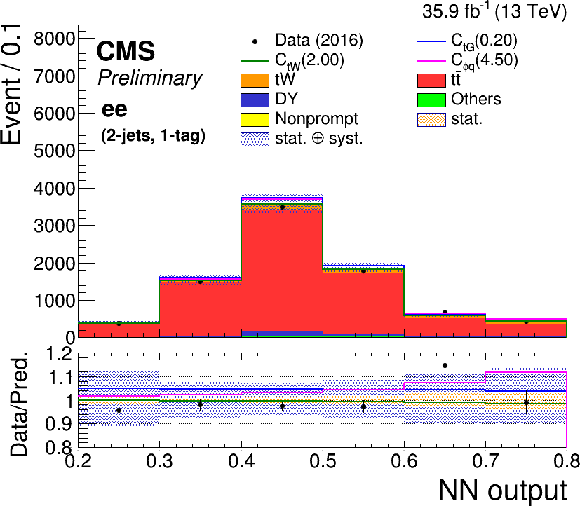
png |
Figure 4-c:
The NN output distributions for data and MC in different categories: (1-jet,1-tag) (upper row), (2-jets,1-tag) (lower row) used in the limit setting for the ee (left column) and μμ (right column) channels. The hatched band corresponds to the sum of the statistical and systematic uncertainties in the event yield for the sum of signal and background predictions. The ratios of data to the sum of the predicted yields are shown at the bottom of each plot. The narrow hatched band represents the contribution from the statistical uncertainty in the MC simulation. |
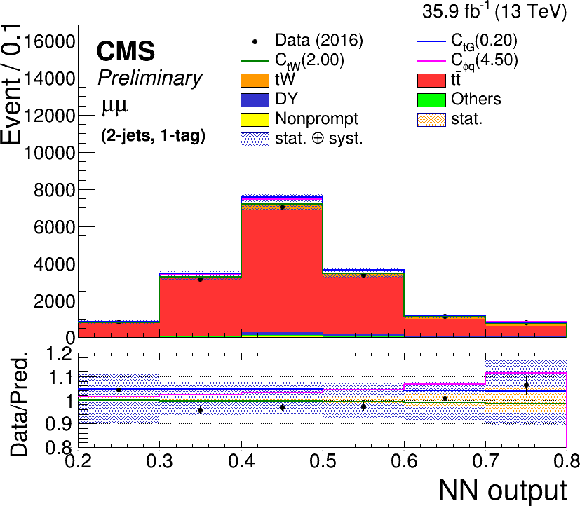
png |
Figure 4-d:
The NN output distributions for data and MC in different categories: (1-jet,1-tag) (upper row), (2-jets,1-tag) (lower row) used in the limit setting for the ee (left column) and μμ (right column) channels. The hatched band corresponds to the sum of the statistical and systematic uncertainties in the event yield for the sum of signal and background predictions. The ratios of data to the sum of the predicted yields are shown at the bottom of each plot. The narrow hatched band represents the contribution from the statistical uncertainty in the MC simulation. |

png pdf |
Figure 5:
The NN output distributions for data and MC in different categories: (1-jet,1-tag) (upper row left), (2-jets,1-tag) (upper row right) and (1-jet,0-tag) (lower row) used in the limit setting for the eμ channel. The hatched band corresponds to the sum of the statistical and systematic uncertainties in the event yield for the sum of signal and background predictions. The ratios of data to the sum of the predicted yields are shown at the bottom of each plot. The narrow hatched band represents the contribution from the statistical uncertainty in the MC simulation. |

png |
Figure 5-a:
The NN output distributions for data and MC in different categories: (1-jet,1-tag) (upper row left), (2-jets,1-tag) (upper row right) and (1-jet,0-tag) (lower row) used in the limit setting for the eμ channel. The hatched band corresponds to the sum of the statistical and systematic uncertainties in the event yield for the sum of signal and background predictions. The ratios of data to the sum of the predicted yields are shown at the bottom of each plot. The narrow hatched band represents the contribution from the statistical uncertainty in the MC simulation. |
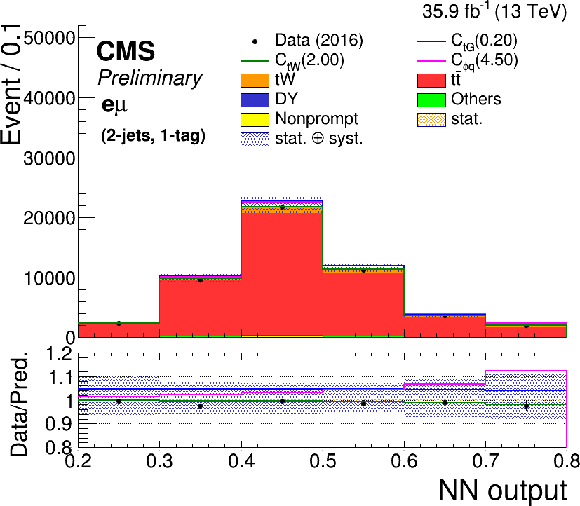
png |
Figure 5-b:
The NN output distributions for data and MC in different categories: (1-jet,1-tag) (upper row left), (2-jets,1-tag) (upper row right) and (1-jet,0-tag) (lower row) used in the limit setting for the eμ channel. The hatched band corresponds to the sum of the statistical and systematic uncertainties in the event yield for the sum of signal and background predictions. The ratios of data to the sum of the predicted yields are shown at the bottom of each plot. The narrow hatched band represents the contribution from the statistical uncertainty in the MC simulation. |
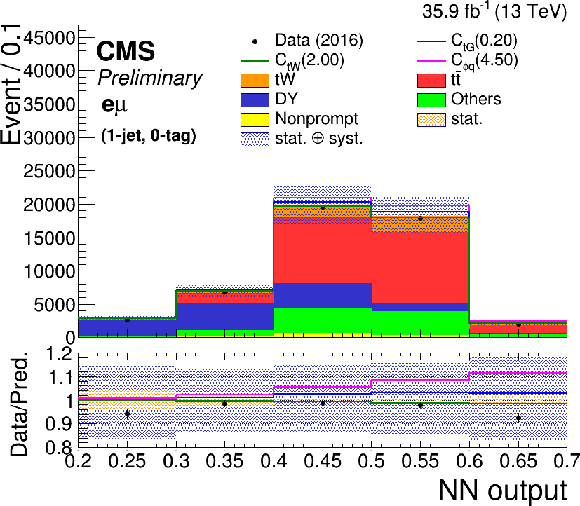
png |
Figure 5-c:
The NN output distributions for data and MC in different categories: (1-jet,1-tag) (upper row left), (2-jets,1-tag) (upper row right) and (1-jet,0-tag) (lower row) used in the limit setting for the eμ channel. The hatched band corresponds to the sum of the statistical and systematic uncertainties in the event yield for the sum of signal and background predictions. The ratios of data to the sum of the predicted yields are shown at the bottom of each plot. The narrow hatched band represents the contribution from the statistical uncertainty in the MC simulation. |
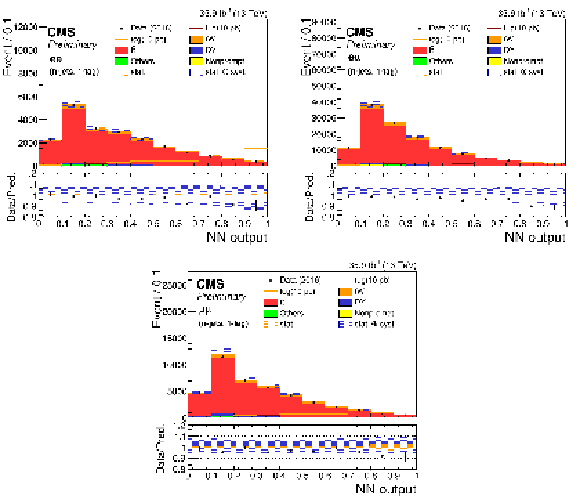
png pdf |
Figure 6:
The NN output distribution for data, MC and FCNC signals in the (njets,1-tag) category used in the limit setting for the ee (upper row left), eμ (upper row right) and μμ (lower row) channels. The hatched band corresponds to the sum of the statistical and systematic uncertainties in the event yield for the sum of signal and background predictions. The ratios of data to the sum of the predicted yields are shown at the bottom of each plot. The narrow hatched band represents the contribution from the statistical uncertainty in the MC simulation. |
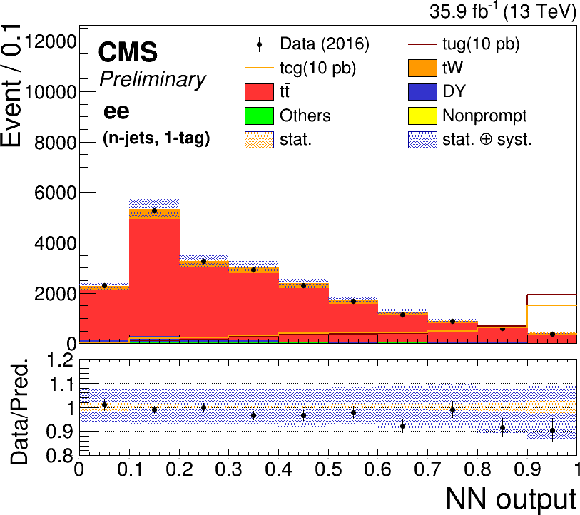
png |
Figure 6-a:
The NN output distribution for data, MC and FCNC signals in the (njets,1-tag) category used in the limit setting for the ee (upper row left), eμ (upper row right) and μμ (lower row) channels. The hatched band corresponds to the sum of the statistical and systematic uncertainties in the event yield for the sum of signal and background predictions. The ratios of data to the sum of the predicted yields are shown at the bottom of each plot. The narrow hatched band represents the contribution from the statistical uncertainty in the MC simulation. |

png |
Figure 6-b:
The NN output distribution for data, MC and FCNC signals in the (njets,1-tag) category used in the limit setting for the ee (upper row left), eμ (upper row right) and μμ (lower row) channels. The hatched band corresponds to the sum of the statistical and systematic uncertainties in the event yield for the sum of signal and background predictions. The ratios of data to the sum of the predicted yields are shown at the bottom of each plot. The narrow hatched band represents the contribution from the statistical uncertainty in the MC simulation. |

png |
Figure 6-c:
The NN output distribution for data, MC and FCNC signals in the (njets,1-tag) category used in the limit setting for the ee (upper row left), eμ (upper row right) and μμ (lower row) channels. The hatched band corresponds to the sum of the statistical and systematic uncertainties in the event yield for the sum of signal and background predictions. The ratios of data to the sum of the predicted yields are shown at the bottom of each plot. The narrow hatched band represents the contribution from the statistical uncertainty in the MC simulation. |
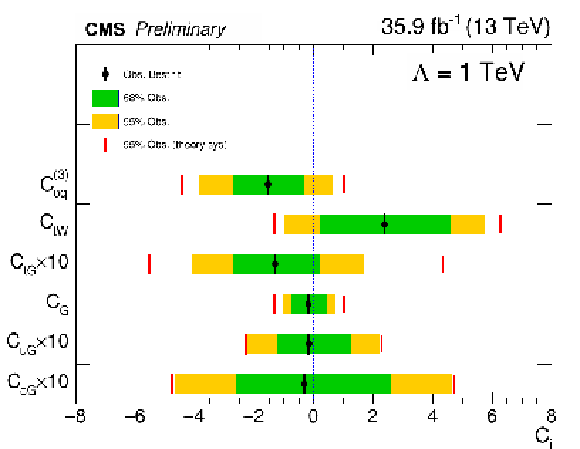
png pdf |
Figure 7:
Observed best fit together with one and two standard deviation bounds on the top quark effective couplings. The blue dashed line shows the SM expectation and the red verical lines indicate the 95 CL bounds including the theoretical uncertainties. |
| Tables | |
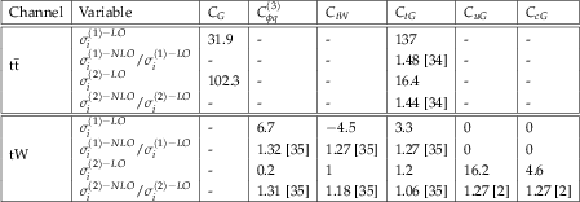
png pdf |
Table 1:
Cross sections for t¯t and tW production [in pb] for the various effective couplings for λ= 1 TeV. The respective available K-factors are also shown. |

png pdf |
Table 2:
Numbers of expected events from tW, t¯t and DY production, from the remaining backgrounds (other and nonprompt backgrounds), total background contribution and observed events in data after all selections for the ee, eμ and μμ channels and for various (n-jets,m-tags) categories. The uncertainties correspond to the statistical contribution only for the individual background predictions and to the quadratic sum of the statistical and systematic contributions for the total background predictions. |
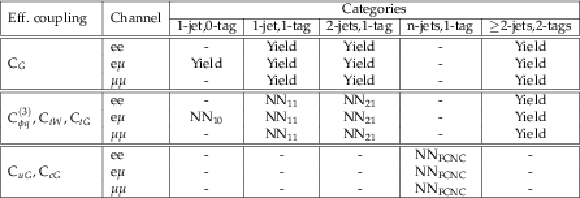
png pdf |
Table 3:
Summary of the observables used for probing effective couplings in various (n-jets,m-tags) categories in the ee, eμ, μμ channels. |
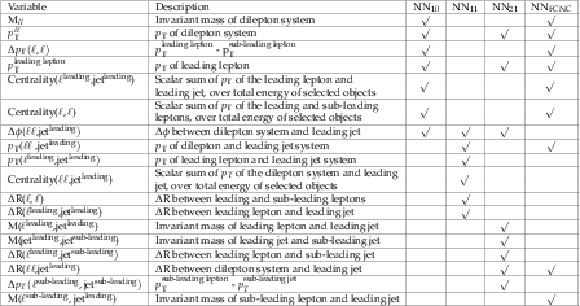
png pdf |
Table 4:
Input variables for the NN used in the analysis in various bins of n-jets and m-tags. The symbols "v" indicate the variables used for the 3 categories and for the FCNC analysis. |

png pdf |
Table 5:
Summary of the observed and expected allowed intervals at 68% CL (best fit values with up and low limits) and 95 CL (in square brackets) on the effective couplings obtained in the ee, eμ, μμ channels and all channels combined. |
| Summary |
| A search for new physics in top quark interactions is performed using dilepton final state events. The single top quark production in association with a W boson is probed for the first time together with the top quark pair production to find the new physics signatures. The analysis is based on 35.9 fb−1 of data from proton-proton collisions at 13 TeV collected by the CMS detector in 2016. No significant excess above the standard model background expectation is observed. The results are interpreted to constrain the relevant effective couplings using a dedicated multivariate analysis. The observed 95% CL limit band on effective couplings are found to be [−1.01,0.70] for CG, [−0.41,0.17] for CtG, [−0.96,5.74] for CtW and [−3.82,0.63] for C(3)ϕq. The corresponding expected limits are [−1.07,0.76] for CG, [−0.30,0.28] for CtG, [−1.91,6.70] for CtW and [−2.04,1.63] for C(3)ϕq. For the FCNC effective couplings, the observed limits are [−0.22,0.22] and [−0.46,0.46] for CuG and CcG, respectively; the expected limit being [−0.30,0.30] and [−0.65,0.65]. The extracted values give the first experimental bound on the CG coupling and improve upon limits previously obtained at 8 TeV for CtG. The limits obtained on the CtW, C(3)ϕq, CuG and CcG couplings from the tW process are complementary to the limits from the single top t-channel process. |
| References | ||||
| 1 | C. Zhang and S. Willenbrock | Effective-Field-Theory Approach to Top-Quark Production and Decay | PRD 83 (2011) 034006 | 1008.3869 |
| 2 | G. Durieux, F. Maltoni, and C. Zhang | Global approach to top-quark flavor-changing interactions | PRD 91 (2015) 074017 | 1412.7166 |
| 3 | B. Grzadkowski, M. Iskrzynski, M. Misiak, and J. Rosiek | Dimension-Six Terms in the Standard Model Lagrangian | JHEP 10 (2010) 085 | 1008.4884 |
| 4 | P. L. Cho and E. H. Simmons | Searching for G3 in tˉt production | PRD 51 (1995) 2360 | hep-ph/9408206 |
| 5 | D0 Collaboration | Combination of searches for anomalous top quark couplings with 5.4~fb−1 of pˉp collisions | PLB 713 (2012) 165 | 1204.2332 |
| 6 | ATLAS Collaboration | Probing the Wtb vertex structure in t-channel single-top-quark production and decay in pp collisions at √s= 8 TeV with the ATLAS detector | JHEP 04 (2017) 124 | 1702.08309 |
| 7 | ATLAS Collaboration | Measurement of the W boson polarisation in tˉt events from pp collisions at √s= 8 TeV in the lepton+jets channel with ATLAS | EPJC 77 (2017) 264 | 1612.02577 |
| 8 | CMS Collaboration | Search for anomalous Wtb couplings and flavour-changing neutral currents in t-channel single top quark production in pp collisions at √s= 7 and 8 TeV | JHEP 02 (2017) 028 | CMS-TOP-14-007 1610.03545 |
| 9 | CMS Collaboration | Measurement of the W boson helicity in events with a single reconstructed top quark in pp collisions at √s= 8 TeV | JHEP 01 (2015) 053 | CMS-TOP-12-020 1410.1154 |
| 10 | CMS Collaboration | Measurements of tˉt spin correlations and top quark polarization using dilepton final states in pp collisions at √s= 8 TeV | PRD 93 (2016) 052007 | CMS-TOP-14-023 1601.01107 |
| 11 | D0 Collaboration | Search for flavor changing neutral currents via quark-gluon couplings in single top quark production using 2.3 fb−1 of pˉp collisions | PLB 693 (2010) 81 | 1006.3575 |
| 12 | CDF Collaboration | Search for top-quark production via flavor-changing neutral currents in W+1 jet events at CDF | PRL 102 (2009) 151801 | 0812.3400 |
| 13 | ATLAS Collaboration | Search for single top-quark production via flavour-changing neutral currents at 8 TeV with the ATLAS detector | EPJC 76 (2016) 55 | 1509.00294 |
| 14 | S. Frixione, P. Nason, and C. Oleari | Matching NLO QCD computations with parton shower simulations: the POWHEG method | JHEP 11 (2007) 070 | 0709.2092 |
| 15 | S. Alioli, P. Nason, C. Oleari, and E. Re | A general framework for implementing NLO calculations in shower Monte Carlo programs: the POWHEG BOX | JHEP 06 (2010) 043 | 1002.2581 |
| 16 | E. Re | Single-top Wt-channel production matched with parton showers using the POWHEG method | EPJC 71 (2011) 1547 | 1009.2450 |
| 17 | S. Alioli, P. Nason, C. Oleari, and E. Re | NLO single-top production matched with shower in POWHEG: s- and t-channel contributions | JHEP 09 (2009) 111 | 0907.4076 |
| 18 | T. Sjostrand et al. | An Introduction to PYTHIA 8.2 | CPC 191 (2015) 159 | 1410.3012 |
| 19 | CMS Collaboration | Event generator tunes obtained from underlying event and multiparton scattering measurements | EPJC 76 (2016) 155 | CMS-GEN-14-001 1512.00815 |
| 20 | CMS Collaboration | Investigations of the impact of the parton shower tuning in pythia 8 in the modelling of t¯t at √s= 8 and 13 TeV | CMS-PAS-TOP-16-021 | |
| 21 | NNPDF Collaboration | Parton distributions for the LHC Run II | JHEP 04 (2015) 040 | 1410.8849 |
| 22 | M. Czakon and A. Mitov | Top++: A Program for the Calculation of the Top-Pair Cross-Section at Hadron Colliders | CPC 185 (2014) 2930 | 1112.5675 |
| 23 | N. Kidonakis | Theoretical results for electroweak-boson and single-top production | PoS DIS2015 (2015) 170 | 1506.04072 |
| 24 | M. Czakon et al. | Top-pair production at the LHC through NNLO QCD and NLO EW | JHEP 10 (2017) 186 | 1705.04105 |
| 25 | J. Alwall et al. | MadGraph/MadEvent v4: The New Web Generation | JHEP 09 (2007) 028 | 0706.2334 |
| 26 | J. Alwall et al. | The automated computation of tree-level and next-to-leading order differential cross sections, and their matching to parton shower simulations | JHEP 07 (2014) 079 | 1405.0301 |
| 27 | R. Frederix and S. Frixione | Merging meets matching in MC@NLO | JHEP 12 (2012) 061 | 1209.6215 |
| 28 | Y. Li and F. Petriello | Combining QCD and electroweak corrections to dilepton production in FEWZ | PRD 86 (2012) 094034 | 1208.5967 |
| 29 | T. Gehrmann et al. | W+W− Production at Hadron Colliders in Next to Next to Leading Order QCD | PRL 113 (2014) 212001 | 1408.5243 |
| 30 | GEANT4 Collaboration | Geant4: A simulation toolkit | NIMA 506 (2003) 250 | |
| 31 | J. Allison et al. | Geant4 developments and applications | IEEE Trans. Nucl. Sci. 53 (2006) 270 | |
| 32 | C. Degrande et al. | UFO - The Universal FeynRules Output | CPC 183 (2012) 1201 | 1108.2040 |
| 33 | A. Alloul et al. | FeynRules 2.0 - A complete toolbox for tree-level phenomenology | CPC 185 (2014) 2250 | 1310.1921 |
| 34 | D. Buarque Franzosi and C. Zhang | Probing the top-quark chromomagnetic dipole moment at next-to-leading order in QCD | PRD 91 (2015) 114010 | 1503.08841 |
| 35 | C. Zhang | Single Top Production at Next-to-Leading Order in the Standard Model Effective Field Theory | PRL 116 (2016) 162002 | 1601.06163 |
| 36 | CMS Collaboration | Measurement of the tˉt production cross section using events in the eμ final state in pp collisions at √s= 13 TeV | EPJC 77 (2017) 172 | CMS-TOP-16-005 1611.04040 |
| 37 | CMS Collaboration | Particle-flow reconstruction and global event description with the CMS detector | JINST 12 (2017) P10003 | CMS-PRF-14-001 1706.04965 |
| 38 | CMS Collaboration | Performance of Electron Reconstruction and Selection with the CMS Detector in Proton-Proton Collisions at √s= 8 TeV | JINST 10 (2015) P06005 | CMS-EGM-13-001 1502.02701 |
| 39 | CMS Collaboration | Performance of CMS muon reconstruction in pp collision events at √s= 7 TeV | JINST 7 (2012) P10002 | CMS-MUO-10-004 1206.4071 |
| 40 | M. Cacciari, G. P. Salam, and G. Soyez | FastJet user manual | EPJC 72 (2012) 1896 | 1111.6097 |
| 41 | M. Cacciari, G. P. Salam, and G. Soyez | The anti-kT jet clustering algorithm | JHEP 04 (2008) 063 | 0802.1189 |
| 42 | M. Cacciari and G. P. Salam | Dispelling the N3 myth for the kT jet-finder | Phys. Lett.B 641 (2006) 57 | hep-ph/0512210 |
| 43 | CMS Collaboration | Jet energy scale and resolution in the CMS experiment in pp collisions at 8 TeV | JINST 12 (2017) P02014 | CMS-JME-13-004 1607.03663 |
| 44 | CMS Collaboration | Identification of heavy-flavour jets with the CMS detector in pp collisions at 13 TeV | JINST 13 (2018) P05011 | CMS-BTV-16-002 1712.07158 |
| 45 | CMS Collaboration | Performance of the CMS missing transverse momentum reconstruction in pp data at √s= 8 TeV | JINST 10 (2015) P02006 | CMS-JME-13-003 1411.0511 |
| 46 | CMS Collaboration | First Measurement of the Cross Section for Top-Quark Pair Production in Proton-Proton Collisions at √s= 7 TeV | PLB 695 (2011) 424 | CMS-TOP-10-001 1010.5994 |
| 47 | B. H. Denby | The use of neural networks in high-energy physics | Neural Comput. 5 (1993) 505 | |
| 48 | CMS Collaboration | Measurement of the production cross section for single top quarks in association with W bosons in proton-proton collisions at √s= 13 TeV | Submitted to: JHEP (2018) | CMS-TOP-17-018 1805.07399 |
| 49 | CMS Collaboration | CMS luminosity measurements for the 2016 data taking period | CMS-PAS-LUM-17-001 | |
| 50 | CMS Collaboration | Measurements of Inclusive W and Z Cross Sections in pp Collisions at √s= 7 TeV | JHEP 01 (2011) 080 | CMS-EWK-10-002 1012.2466 |
| 51 | CMS Collaboration | Determination of Jet Energy Calibration and Transverse Momentum Resolution in CMS | JINST 6 (2011) P11002 | CMS-JME-10-011 1107.4277 |
| 52 | CMS Collaboration | Measurements of differential cross sections for tˉt production in proton-proton collisions at √s= 13 TeV using events containing two leptons | ||
| 53 | CMS Collaboration | Measurement of differential cross sections for Z boson production in association with jets in proton-proton collisions at √s= 13 TeV | Submitted to: EPJC (2018) | CMS-SMP-16-015 1804.05252 |
| 54 | CMS Collaboration | Measurement of the cross section for top quark pair production in association with a W or Z boson in proton-proton collisions at √s= 13 TeV | JHEP 08 (2018) 011 | CMS-TOP-17-005 1711.02547 |
| 55 | CMS Collaboration | Measurement of the top quark mass using proton-proton data at √s~=~7 and 8 TeV | PRD 93 (2016) 072004 | CMS-TOP-14-022 1509.04044 |
| 56 | S. Frixione et al. | Single-top hadroproduction in association with a W boson | JHEP 07 (2008) 029 | 0805.3067 |
| 57 | J. M. Campbell and F. Tramontano | Next-to-leading order corrections to Wt production and decay | NPB 726 (2005) 109--130 | hep-ph/0506289 |
| 58 | A. Belyaev and E. Boos | Single top quark tW + X production at the CERN LHC: A Closer look | PRD 63 (2001) 034012 | hep-ph/0003260 |
| 59 | P. Skands, S. Carrazza, and J. Rojo | Tuning PYTHIA 8.1: the Monash 2013 Tune | EPJC 74 (2014) 3024 | 1404.5630 |

|
Compact Muon Solenoid LHC, CERN |

|

|

|

|

|

|